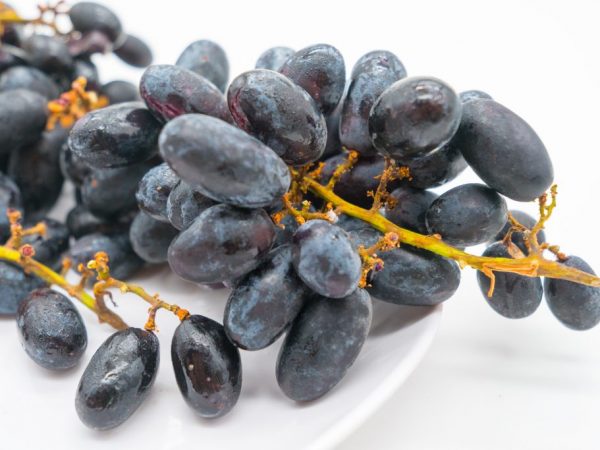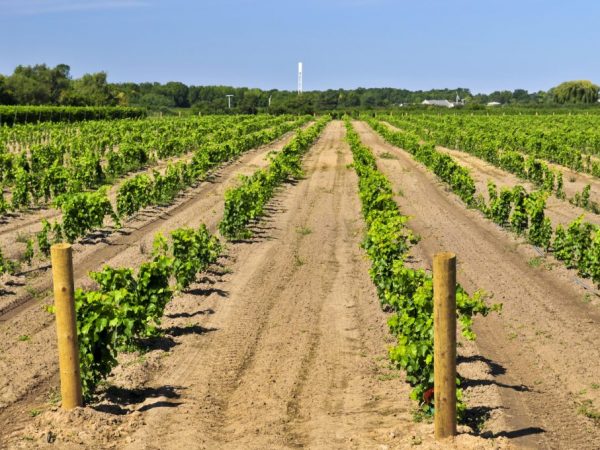The cultivation of the grapes of Athos
In the early 2000s, the Atos grape appeared on the market. This variety is suitable for gardeners who do not want to spend a lot of time caring for their crops. The crop is harvested in July.

The cultivation of the grapes of Athos
General description of the culture
Athos table grapes are classified as ultra-early crops. Its growing season is only 70-80 days. The flowers are unisexual, but this does not prevent the culture from pollinating itself on its own. According to the description, the variety is able to withstand low temperatures down to -25 ° C.
Features of the bush
Bushes grow up to 4 m in height. The vine is powerful, spreading. The leaf plate is dark green, five-lobed. Its dimensions are 8x5 cm. On the surface there are rough areas and small thin stripes. No wax coating is observed.
Features of the fruit
The berries of the Athos grape are medium in size. Their weight does not exceed 6 g. The shape is oval, even. The peel is smooth, since there is a small amount of waxy coating on its surface. According to the description of the Athos grape variety, the color of the skin is deep pink, which makes it possible to add a slight contrast to the garden area.
The berries form large cylindrical clusters. Their weight reaches 800-900 g.
The taste of this variety is high. Muscat notes are clearly audible in both taste and aroma. The fruit is ideal for fresh consumption, raisins or dessert wine. They are stored for a long time if kept at a temperature of -2 ° C.
The fruits are suitable for long-term transportation, which allows them to be used for sale.
Growing
When planting a crop, it is important to consider the terrain. In the central and southern regions of the country, planting is carried out at the end of March. For those living in the northern part, it is better to postpone the planting process until mid-April.
Despite the high resistance of the variety to frost, young seedlings need to be given time to get used to the environment. It is better to plant Athos grapes in sunny areas. This will speed up the ripening process of the fruit.
Protection from the wind is also important for culture, so the seedlings are placed near fences or buildings.
When choosing a seedling, several basic parameters are taken into account:
- the minimum height must be 1 m;
- root system length - 20-25 cm;
- there must be a spot on the surface indicating the presence of vaccination;
- there should be no dry or diseased areas: if there is a place on the seedling that indicates a past disease, it is better to refuse it.
Landing features

The distance between the rows must be at least 3 m
A landing hole is being prepared in the fall. Its depth should be 70 cm, and its width - 80 cm. A drainage system is installed at the bottom using rubble and tree branches. After that, the soil is fed with a mixture of humus and compost to improve its nutritional value.
In the spring, a seedling is placed in the prepared hole, the roots are distributed evenly. The neck near the roots must be above the ground for the plant to grow properly. The roots are covered with the top layer of soil.The bush is watered with 20 liters of warm water.
The bushes of this variety are tall, so they need support. A support in the form of a metal rod is placed near the seedling, which protects the young seedling from deformation in windy weather.
When landing, adhere to the correct scheme. The distance between the rows should be 3 m. Between the bushes it is reduced to 2 m.
Care
Culture care is simple, does not require special knowledge. The Athos grape variety needs high-quality watering. Its frequency is 15 days. Use water at room temperature, which enhances the adhesion of roots and soil. 15 liters of water are poured under each bush. If the climate is hot, the volume is increased to 20 liters.
Top dressing is carried out infrequently. The genetics of this hybrid variety already implies the size of the fruit. In the spring, under each bush, add 20 liters of ammonium nitrate solution (20 g per 10 liters of water). If desired, the bushes are fed with superphosphate (40 g per 10 l of water), if it is important to speed up the harvest time.
A few weeks before harvesting the fruits, remove the lower parts of the shoots and thin out the crown. This speeds up the pouring of the fruit. Pruning is carried out in the spring: dry and diseased parts of the vine and antennae are removed.
Protection from pests and diseases
The grape variety Atos has a high resistance to root rot and powdery mildew.
Of all diseases, this variety is affected only by gray rot. Gray spots form on the leaves, which after some time turn yellow and completely destroy the leaf plate. Treatment for this disease involves regular spraying with chemicals. For these purposes, Topsin's solution (30 g per 10 liters of water) or Benleit's solution (50 g per 10 liters of water) is ideal. The processing interval is 20 days.
Of the pests, an invasion of ticks, wasps and fleas is often observed:
- Special traps using honey or jam help to fight wasps. They are installed both from the bottom of the bush and hanging from a support.
- Spraying with an interval of 10 days with a solution of Penocnazole (40 g per 10 liters of water) will help get rid of ticks.
- In the fight against fleas, drugs with a high concentration of copper in the composition are used. The best option is Oxyhom (40 g per 10 liters of water).
- Sometimes the bushes of this variety are affected by the leafworm. A solution of Karbofos (50 g per 10 liters of water) will help get rid of it.
Conclusion
The Athos variety is considered unpretentious to care for. Even inexperienced gardeners grow it. The crop is harvested from 2 years after planting. The only requirement is to adhere to care measures and protect the plant from parasites and diseases.


